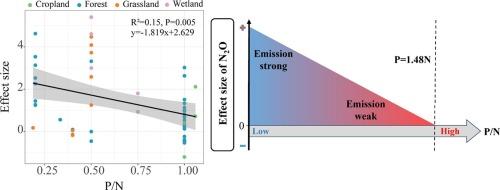Additive effects dominate phosphorus offsetting positive effects of nitrogen to terrestrial ecosystem N2O emissions
IF 6.6
1区 农林科学
Q1 SOIL SCIENCE
引用次数: 0
Abstract
Nitrous oxide (N2O) emissions from terrestrial ecosystem significantly contribute to global warming and are substantially influenced by nitrogen (N) and phosphorus (P) additions. Yet, the precise interactive effects of N and P addition on N2O emissions remain poorly understood. We synthesized 714 observations from 198 publications to evaluate the response of N2O emission rates to N and P addition across terrestrial ecosystems. Our results revealed that N and nitrogen + phosphorus (NP) additions increased N2O emissions by 122.5 % and 64.5 %, respectively. In contrast, P addition alone reduced N2O emissions by 16.3 %. Akaike mixed model weights identified ecosystem type as a factor commonly influencing N2O emissions under added N, P, and NP. Predominantly additive interactions between N and P additions drove N2O emission responses, rather than synergistic or antagonistic interactions. Antagonistic effects were exclusively observed in cropland ecosystems. Collectively, these findings demonstrate that N and P addition exhibit independent and additive effects on N2O emissions in terrestrial ecosystems. This implies that the stimulatory effect of N and the inhibitory effect of P can be quantitatively combined to improve predictions of N2O emissions under nutrient enrichment scenarios.

磷的加性效应占主导地位,抵消了氮对陆地生态系统N2O排放的积极影响
陆地生态系统的氧化亚氮(N2O)排放对全球变暖有重要贡献,并受到氮(N)和磷(P)添加量的显著影响。然而,氮和磷添加对N2O排放的精确交互效应仍然知之甚少。我们综合了198篇出版物中的714个观测值,评估了陆地生态系统N2O排放率对N和P添加的响应。结果表明,氮和氮+磷(NP)的添加分别使N2O排放量增加了122.5%和64.5%。相比之下,单独添加磷可以减少16.3%的N2O排放。Akaike混合模型权重认为,在N、P和NP添加下,生态系统类型通常是影响N2O排放的因素。N和P添加之间的加性相互作用是驱动N2O排放响应的主要因素,而不是协同或拮抗相互作用。拮抗作用仅在农田生态系统中观察到。综上所述,这些发现表明,氮和磷添加对陆地生态系统N2O排放具有独立和加性的影响。这意味着氮的刺激作用和磷的抑制作用可以定量结合起来,以改善养分富集情景下N2O排放的预测。
本文章由计算机程序翻译,如有差异,请以英文原文为准。
求助全文
约1分钟内获得全文
求助全文
来源期刊

Geoderma
农林科学-土壤科学
CiteScore
11.80
自引率
6.60%
发文量
597
审稿时长
58 days
期刊介绍:
Geoderma - the global journal of soil science - welcomes authors, readers and soil research from all parts of the world, encourages worldwide soil studies, and embraces all aspects of soil science and its associated pedagogy. The journal particularly welcomes interdisciplinary work focusing on dynamic soil processes and functions across space and time.
 求助内容:
求助内容: 应助结果提醒方式:
应助结果提醒方式:


